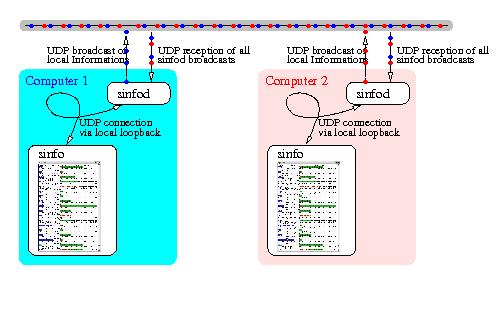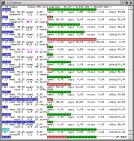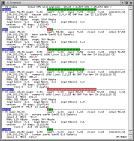|
||||||||||||
|
||||||||||||
|
||||||||||||
|
Don't you know the problem? 1.) There are many computers connected to your local network and you have got the (scientific) programs to use their computational power. But the computers are too different to use some special clustering software. So you are on your own! The first problem you've got to solve is an overview of the available computers an their current load. sinfo is an approach to solve this problem. 2.) You are responsible for an laboratory of public accessible computers. And you need a tool that provides a quick overview of all nodes and the (insane) processes running on it. sinfo can be your choice. sinfo is running for about two years on our local network and has become a tool for daily use. I'm running sinfo on the following systems:
|
||||||||||||
|
||||||||||||
The sinfo-system is split into two parts. A demon and a user program. 1.) The demon (sinfod) distributes system information using UDP broadcasts on the local network. Each demon will also receive UDP broadcasts of all other demons and manage a list of the most recent informations. 2.) The user program (sinfo) connects to the demon via the local loop-back interface and displays the up to date informations using the ncurses library. This scheme has the advantage that it produces minimal network load. If each node broadcasts it's information in a cooperative manner, the network load is O(N), where N is the number of nodes in your network. Other systems to monitor your cluster load (e.g. rup(1) ) are using a polling scheme where every node has to ask every other node for the system information: In that case the network load is O(N**2). The Informations broadcasted include:
|
||||||||||||
|
||||||||||||
|
||||||||||||
|
For documentation look at the man pages of sinfo and sinfod. |
||||||||||||
|
||||||||||||
|
The following tools and libraries are necessary to compile and use sinfo. Most of them should be already available on any modern Linux system. necessary libraries: |
||||||||||||
|
||||||||||||
|
sinfo 0.0.47 - Sun, 08 Jul 2012 08:42:55 +0200
sinfo 0.0.46 - Mon, 14 May 2012 19:41:06 +0200
sinfo 0.0.45 - Tue, 13 Mar 2012 07:07:27 +0100
sinfo 0.0.44 - Tue, 13 Dec 2011 18:32:33 +0100
sinfo 0.0.43 - Thu, 01 Sep 2011 09:00:13 +0200
|
||||||||||||
|
||||||||||||
I've prepared a debian package for this program.
You can download this via
|
||||||||||||
|
||||||||||||
Lately I've seen some sites out there linking sinfo's homepage. If you want your site to be listed here or know a site not listed here, please drop me a line. |
||||||||||||
|
|
||||||||||||


